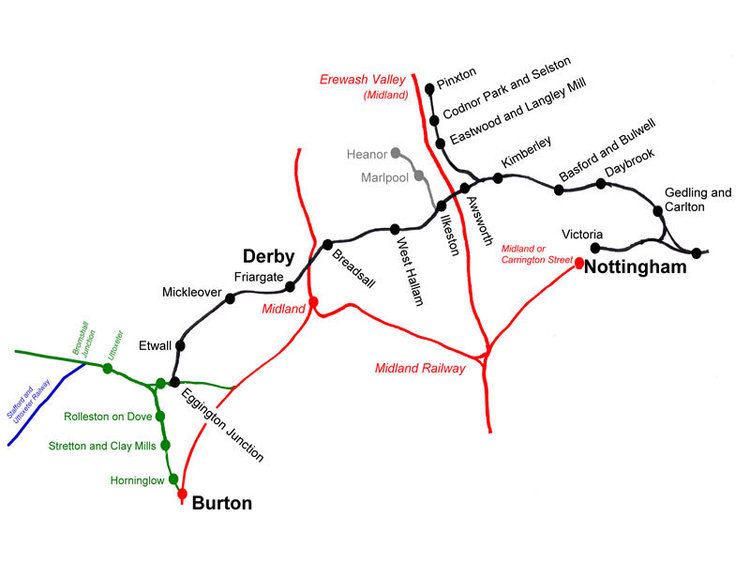 | ||
The Great Northern Railway's Derbyshire and Staffordshire extension, locally known as the Derby Friargate line is a now-closed railway line that linked Nottingham and Grantham to the east of the East Midlands counties to Burton upon Trent to the southwest of the area. It was an extension of the Ambergate, Nottingham, Boston and Eastern Junction Railway which had been acquired by the Great Northern Railway. The route cut a direct line through the midlands industrial city of Derby whereupon an impressive warehouse, large sidings, and the pretty Derby Friargate Station were consructed. The line had such an impact on Derby, Friargate, and the surrounding areas that it became known as the Derby Friargate line.
Contents
The GNR later acquired the Stafford and Uttoxeter Railway in July 1881, gaining a through route from Grantham to Wales via the Ambergate, Nottingham, Boston and Eastern Junction Railway.
History of the line
Businessmen and councillors alike (which at the time often amounted to one and the same thing), wanted to exploit the coal seams around northern Nottinghamshire and Derbyshire, the rail transport of which was controlled by the Midland Railway company which dictated prices; this increased the price of coal dramatically and it was agreed diminished Derby's competitive position as a Midlands industrial town. So eager were Councillors and the general powers that be, to have a second railway line serve Derby, that when the Act ((the Great Northern (Derbyshire and Staffordshire) Act of 1872)), authorising its creation was passed by Parliament, it contained very little protection for local residents. A route had been agreed that practically sliced through the city from East to West and it was not until construction began that the people of Derby belatedly realised what had been signed up to. The Great Northern Railway had carte blanche authority to do practically whatever it needed to complete the route as economically as possible. In fact, looking at an aerial view of the city today, the route of the line can still be made out, almost 50 years after it was closed.
In particular the residential areas around Friargate and South Street were affected, with South Street actually losing almost half its length and truncated by the embankment carrying the line. A worse fate was in store for what was Baxter Street which vanished completely beneath the Great Northern Railway's yard and warehouse. Similarly, Short Street and Cherry Street were demolished to make way for the line. In the case of South Street, the railway company sought to appease the dissatisfaction of residents by building a cast iron footbridge connecting Ponsonby Terrace and Dog Kennel Lane (Great Northern Road). However this was not a particularly satisfactory solution; the problem for Derby Council was that as the railway company had signed up to nothing legally binding to protect the integrity of the area or interests of the residents, any requirements covering such factors had to be done by consent of the Great Northern via mutual agreement with the Council. The result was not a particularly happy relationship!
In addition Uttoxeter Old Road had to be raised above the railway at the point where it was eight tracks wide, creating an awkwardly steeped road and a difficult junction with Parcel Terrace as well as resulting in the demolition of more of the original Victorian terraced housing.
Ilkeston to Friargate
From East to West, the line crossed the famous Bennerley Viaduct (which still stands today) and then headed towards the Derbyshire village of Morley where it cut a route through Morley Tunnel (238 yds) emerging towards Breadsall where a fine country station was built to the same model of those at Mickleover and Etwall. The line then continued on an embankment adjacent to Derby Race Course and then a viaduct (blown up in 1979) carrying the line towards Chester Green, then below several streets being; North Parade, North Street, Arthur Street, Henry Street, Edward Street and King Street whereupon it was carried over an arched bridge over Brook Street and Agard Street to Friargate Station. This is where the railway usurped Short Street which, as the name suggests, was a short street linking Agard Street to Friargate, which vanished beneath the arches carrying the railway. These arches were later used as the depot for Derby Tramway Company.
Friargate to Egginton Junction
On leaving Friargate Station westbound, the line passed underneath the aforementioned Uttoxeter Old Road and then parallel to Slack Lane, adjacent to where the Sainsbury's site now stands, under an extant road bridge (now carrying just a pavement), which used to carry Kingsway and then through Mickleover Tunnel (464 yds). On emerging from the tunnel in a cutting the line then ran under a bridge carrying Station Road and into Mickleover (for Radbourne) Station. Both the station buildings and The Great Northern Hotel, a pub on the other side of Station Road are extant, but the tunnel entrance and cutting as far as the Western side of Station road were infilled with land fill in the early nineteen eighties. The bridge carrying Station Road is still there and there is a small hump in the road as it passes over it, but whereas there would once have been a cutting containing the railway the ground adjacent to the bridge is now at ground level, sloping steeply towards the station on the western side of the bridge. The line then ran through fields and into Etwall which had a country station almost identical to those at Mickleover and Breadsall, thence running south into Egginton and the junction with the main line from Derby to Crewe.
